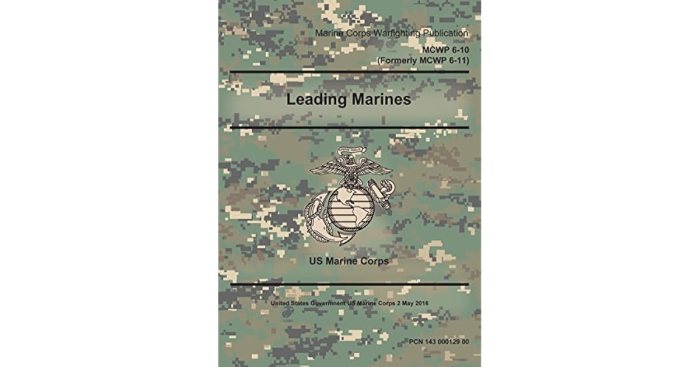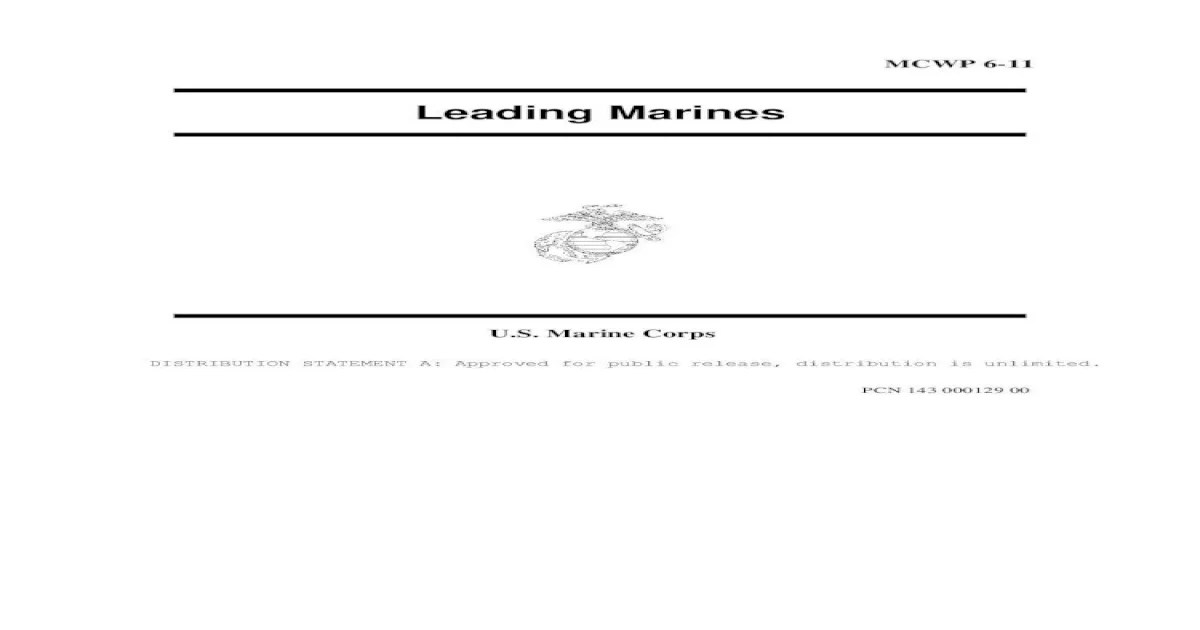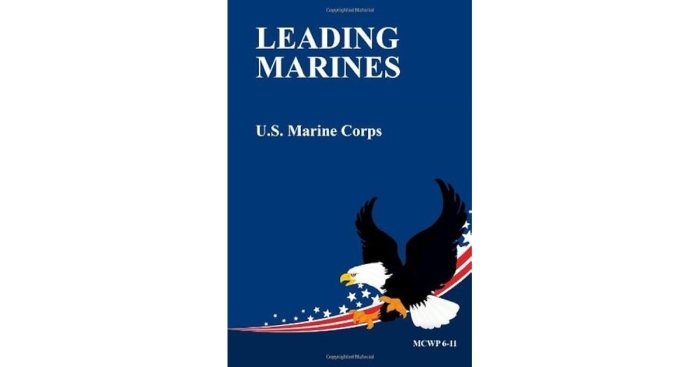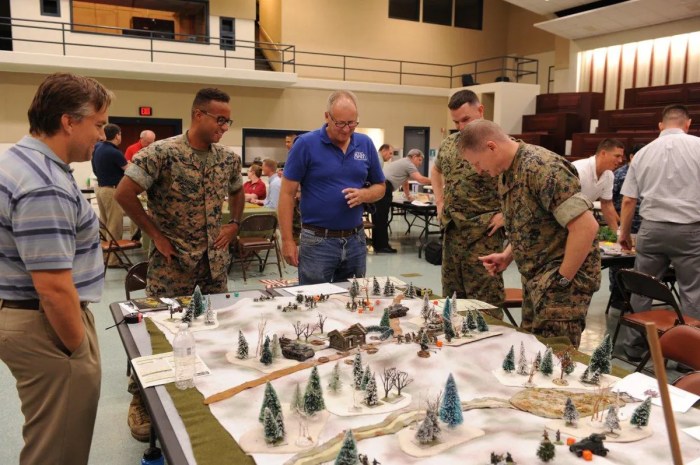Mcwp 6 11 leading marines – MCWP 6-11: Leading Marines stands as a beacon of leadership principles, guiding Marines to triumph in the face of adversity. Delve into this comprehensive guide and uncover the secrets of effective leadership, empowering you to lead with confidence and inspire your team to greatness.
This publication serves as an indispensable resource for Marines at all levels, providing a roadmap for success in the ever-evolving landscape of modern warfare.
Marine Corps Warfighting Publication (MCWP) 6-11

MCWP 6-11, Leading Marines, is a fundamental publication that provides Marines with guidance on leadership principles, techniques, and responsibilities. It is a valuable resource for both junior and senior leaders, offering insights into effective leadership and the development of exceptional Marines.
Target Audience and Intended Use
MCWP 6-11 is primarily intended for all Marines, regardless of rank or experience. It is designed to assist leaders in developing their skills and knowledge in leading Marines effectively. The publication provides guidance on a wide range of leadership topics, including leadership styles, communication, motivation, and decision-making.
Structure and Organization
MCWP 6-11 is organized into five chapters, each covering a specific aspect of leadership:
- Chapter 1: Introduction to Leadership
- Chapter 2: Leading Marines
- Chapter 3: Leading Units
- Chapter 4: Leadership in Combat
- Chapter 5: Developing Leaders
Each chapter is further divided into sections that provide detailed information on specific topics. The publication also includes numerous examples and case studies to illustrate the principles and techniques discussed.
Leadership Principles and Attributes

Marine Corps Warfighting Publication (MCWP) 6-11 Artikels the fundamental principles and attributes that guide effective leadership within the Marine Corps. These principles provide a framework for Marines to develop and apply their leadership skills, fostering a cohesive and mission-oriented force.
Key Leadership Principles
MCWP 6-11 emphasizes several key leadership principles that shape the conduct and effectiveness of leaders. These principles include:
- Mission Accomplishment:Prioritizing the successful execution of assigned missions, placing mission success above personal interests.
- Initiative:Taking proactive steps to anticipate and address challenges, seeking opportunities to improve and excel.
- Decisiveness:Making timely and informed decisions, even in uncertain or complex situations.
- Integrity:Adhering to ethical standards and moral principles, fostering trust and respect among subordinates.
- Accountability:Accepting responsibility for one’s actions and decisions, holding oneself and others accountable for performance.
Essential Attributes of Effective Leaders
Beyond these principles, MCWP 6-11 identifies specific attributes that contribute to the effectiveness of leaders. These attributes include:
- Competence:Possessing the knowledge, skills, and abilities necessary to lead effectively.
- Confidence:Believing in oneself and one’s abilities, inspiring confidence in others.
- Courage:Facing challenges and adversity with determination and resilience.
- Communication:Effectively conveying information, ideas, and orders, fostering understanding and buy-in.
- Empathy:Understanding and relating to the perspectives and emotions of others, fostering a positive and supportive environment.
Examples of Principled Leadership
The principles and attributes Artikeld in MCWP 6-11 translate into tangible leadership behaviors that contribute to mission success. For instance:
- A leader who demonstrates mission accomplishmentensures that the team remains focused on achieving its objectives, even in the face of obstacles.
- A leader who exhibits initiativetakes the lead in identifying and resolving potential problems, preventing setbacks.
- A leader who possesses courageinspires others to overcome fear and uncertainty, leading to greater risk-taking and innovation.
By adhering to the principles and cultivating the attributes Artikeld in MCWP 6-11, leaders within the Marine Corps foster a culture of excellence and effectiveness, ultimately contributing to the success of the organization.
Mission and Decentralized Execution

Mission command is a critical concept in Marine Corps operations. It empowers subordinate leaders to make decisions and take action within the commander’s intent, fostering initiative and adaptability on the battlefield.
Role of Decentralized Execution
Decentralized execution is the process of empowering subordinate leaders to make decisions and take actions within the commander’s intent. This allows for faster and more effective decision-making, as subordinates can respond to changing situations on the ground without having to wait for orders from higher headquarters.
Examples of Successful Mission Command and Decentralized Execution
- Battle of Belleau Wood (1918):The Marines’ decentralized execution allowed them to adapt to the changing battlefield conditions and ultimately defeat the German forces.
- Operation Desert Storm (1991):The decentralized execution of the Marine Corps’ ground forces allowed them to maneuver quickly and effectively, contributing to the coalition’s victory.
Planning and Preparation
Planning and preparation are critical to the success of any operation. Effective planning and preparation enable Marines to anticipate challenges, mitigate risks, and execute missions efficiently. Key steps in the planning process include intelligence gathering, risk assessment, and contingency planning.
Intelligence Gathering
Intelligence gathering provides essential information about the operational environment, including terrain, enemy forces, and potential threats. This information allows Marines to make informed decisions and develop appropriate plans.
Risk Assessment
Risk assessment involves identifying and evaluating potential risks associated with an operation. By assessing risks, Marines can prioritize threats, develop mitigation strategies, and reduce the likelihood of mission failure.
Contingency Planning
Contingency planning involves developing alternative plans to address unforeseen events or changes in the operational environment. By preparing for contingencies, Marines can adapt quickly to changing circumstances and ensure mission success.
Effective planning and preparation processes involve thorough analysis, coordination, and communication. Marines must consider all relevant factors, anticipate potential challenges, and develop plans that are flexible and adaptable.
Command and Control

Command and control (C2) are critical elements of Marine Corps operations, enabling commanders to effectively direct and coordinate their forces. C2 systems provide the means to communicate orders, receive feedback, and monitor the execution of plans.The principles of C2 include:
-
-*Unity of command
Each unit has a single commander responsible for all aspects of its operations.
-*Chain of command
Orders flow from higher headquarters to subordinate units through a clear and unbroken chain of authority.
-*Span of control
The number of subordinates that a commander can effectively control is limited.
-*Mission-type orders
Commanders provide subordinates with clear and concise orders that specify the mission, purpose, and intent.
-*Decentralized execution
Subordinate commanders are empowered to make decisions and take action within the limits of their authority.
C2 methods and techniques include:
-
-*Verbal orders
Commanders can issue orders verbally, either in person or over the radio.
-*Written orders
Commanders can issue written orders, such as operation orders (OPORDs) and fragmentary orders (FRAGOs).
-*Visual signals
Commanders can use visual signals, such as hand and arm gestures, to communicate orders.
-*Electronic systems
Commanders can use electronic systems, such as command and control systems (C2S) and tactical data links (TDLs), to communicate orders and receive feedback.
Effective C2 systems are essential for the success of Marine Corps operations. They provide commanders with the ability to:
-
-*Plan and execute operations
C2 systems enable commanders to develop and implement plans for operations.
-*Control their forces
C2 systems allow commanders to control their forces and ensure that they are executing orders as intended.
-*Respond to changes
C2 systems provide commanders with the ability to respond to changes in the operational environment and adjust their plans accordingly.
-*Coordinate with other units
C2 systems enable commanders to coordinate with other units, both within their own service and with other services.
Sustainment and Logistics: Mcwp 6 11 Leading Marines

Sustainment and logistics are crucial aspects of Marine Corps operations, ensuring that Marines in the field have the necessary supplies, equipment, and support to accomplish their missions effectively. Providing these resources presents various challenges and considerations, including transportation, storage, distribution, and maintenance.
Challenges in Sustainment and Logistics
*
-*Harsh Environments
Marines often operate in remote and challenging environments, making it difficult to transport and store supplies.
-
-*Time-Sensitive Operations
The rapid pace of Marine operations requires efficient and responsive logistics to meet changing needs.
-*Limited Resources
Marines must optimize the use of available resources while minimizing waste and maintaining readiness.
Innovative and Effective Solutions
*
-*Expeditionary Logistics
Marines have developed innovative approaches to logistics, such as expeditionary bases and mobile supply points, to provide support in austere environments.
-
-*Intermodal Transportation
Marines utilize a combination of air, land, and sea transportation to deliver supplies efficiently.
-*Advanced Technology
Technology advancements, such as automated inventory management systems and GPS tracking, have enhanced logistics capabilities.
Training and Education

Training and education are essential for developing effective leaders and Marines. They provide the knowledge, skills, and attitudes necessary to succeed in the complex and demanding environment of modern warfare.The Marine Corps offers a wide range of training and education programs to meet the needs of its Marines.
These programs include:
Basic training
Basic training is the foundation of Marine Corps training. It provides Marines with the basic knowledge and skills they need to succeed in the Marine Corps.
Advanced training
Advanced training builds on the skills learned in basic training and provides Marines with the specialized knowledge and skills they need to perform their specific jobs.
Professional military education
Professional military education (PME) is designed to develop the leadership and decision-making skills of Marine officers and senior enlisted Marines.
Education
The Marine Corps encourages Marines to pursue higher education. Marines can take advantage of tuition assistance programs and other educational opportunities to improve their knowledge and skills.
Successful Training and Education Initiatives
The Marine Corps has a number of successful training and education initiatives in place. These initiatives include:
The Marine Corps University
The Marine Corps University is the Marine Corps’ center for professional military education. It offers a wide range of courses and programs to meet the needs of Marine officers and senior enlisted Marines.
The Education Center Program
The Education Center Program provides Marines with access to higher education opportunities. Marines can take classes at colleges and universities near their duty stations or online.
MCWP 6-11 Leading Marines provides a comprehensive guide for developing and sustaining leadership skills. For further insights, consider exploring the analysis of Gary Soto’s “The Jacket” . This thought-provoking work delves into the complexities of human relationships and the power of empathy.
By integrating these perspectives, Marines can enhance their understanding of leadership and effectively navigate the challenges of command.
The Training and Education Command
The Training and Education Command is responsible for the development and delivery of training and education programs for the Marine Corps. It works closely with other organizations to ensure that Marines receive the best possible training and education.
Ethical Considerations and Decision-Making
The Marine Corps emphasizes ethical leadership as a cornerstone of its values and principles. Marine leaders are expected to adhere to a strict code of conduct, guided by ethical principles that ensure the well-being of their subordinates, the integrity of the mission, and the reputation of the Corps.
In the field, Marine leaders may face complex ethical challenges and dilemmas. These challenges can stem from conflicting demands, such as the need to balance mission objectives with the safety and well-being of their troops, or the need to make decisions under pressure with limited information.
Ethical Principles and Values
- Integrity:Upholding honesty, truthfulness, and consistency in words and actions.
- Courage:Facing challenges and making difficult decisions even in the face of adversity.
- Loyalty:Dedicating oneself to the mission, the Corps, and one’s subordinates.
- Fairness:Treating others with impartiality, equity, and respect.
- Responsibility:Taking ownership of one’s actions and decisions, and being accountable for their consequences.
Ethical Challenges and Dilemmas
- Balancing mission objectives with troop welfare:Deciding how to proceed when the mission requires taking risks that could endanger the lives of subordinates.
- Making decisions under pressure:Acting ethically when time is short, information is limited, and the stakes are high.
- Dealing with moral conflicts:Facing situations where different ethical principles seem to conflict, such as the need to obey orders versus the need to protect civilians.
Examples of Ethical Decision-Making, Mcwp 6 11 leading marines
- In combat:Choosing to withdraw troops from a dangerous situation despite the potential impact on the mission.
- In garrison:Addressing allegations of misconduct by subordinates, even if it means holding them accountable.
- In training:Ensuring that training exercises are conducted safely and ethically, even if it means sacrificing realism.
Quick FAQs
What is the primary purpose of MCWP 6-11?
MCWP 6-11 serves as a comprehensive guide to leadership principles and practices within the Marine Corps, empowering Marines to lead effectively in various operational environments.
Who is the intended audience for MCWP 6-11?
MCWP 6-11 is primarily intended for Marine Corps leaders at all levels, from junior officers to senior commanders. It provides invaluable insights and guidance for Marines seeking to enhance their leadership abilities.
How is MCWP 6-11 structured?
MCWP 6-11 is organized into eight chapters, each focusing on a specific aspect of leadership, including leadership principles, mission command, planning and preparation, command and control, sustainment and logistics, training and education, ethical considerations, and decision-making.